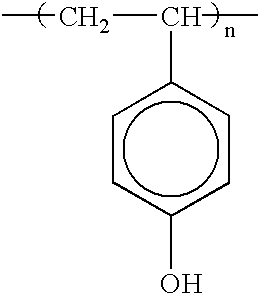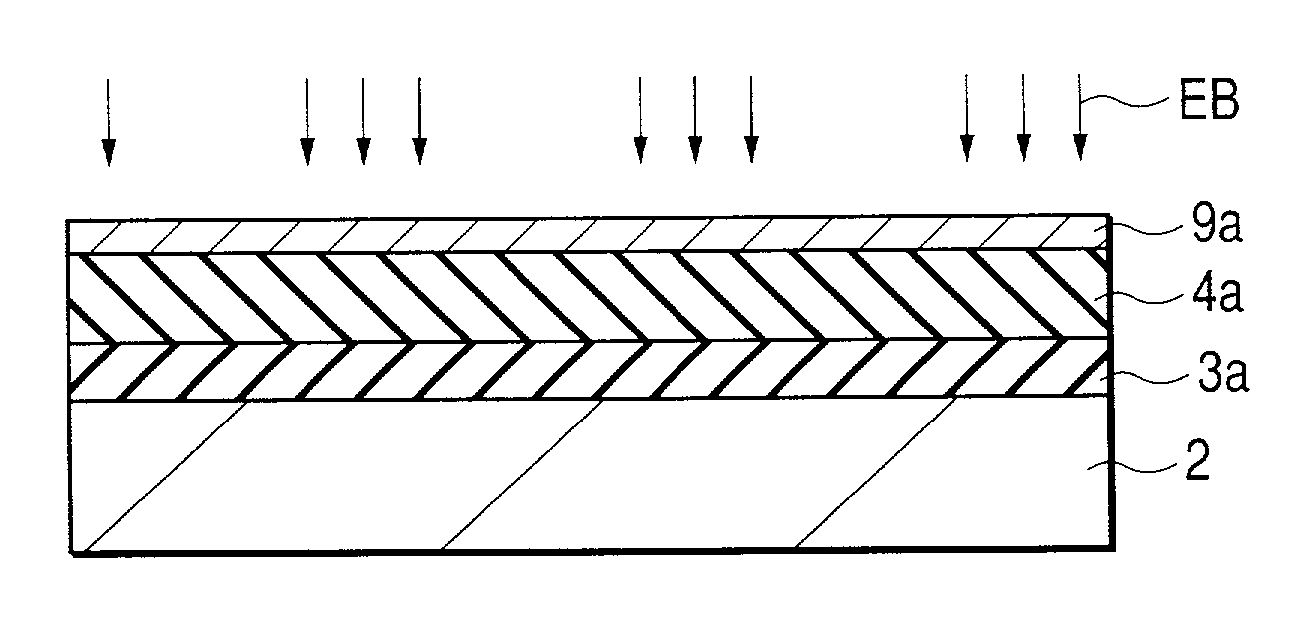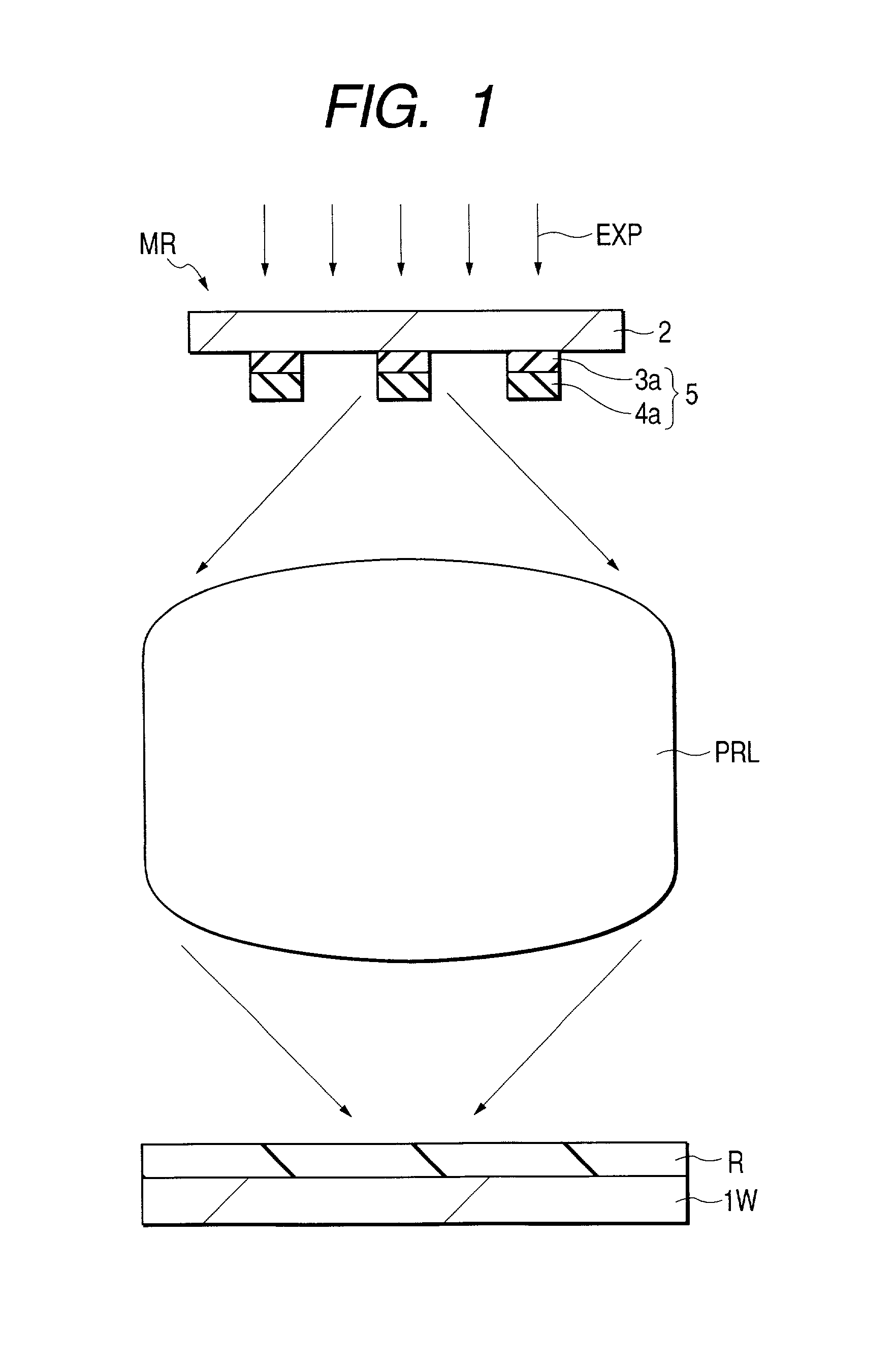Method of manufacturing a semiconductor device
a manufacturing method and semiconductor technology, applied in the direction of photomechanical equipment, instruments, originals for photomechanical treatment, etc., can solve the problems of increasing costs, reducing processing accuracy, and requiring many manufacturing processes
- Summary
- Abstract
- Description
- Claims
- Application Information
AI Technical Summary
Benefits of technology
Problems solved by technology
Method used
Image
Examples
embodiment 1
[0119] (Embodiment 1)
[0120] As shown in FIG. 1 for exposure according to this embodiment of the present invention, exposure light EXP generated from an exposure light source is irradiated onto a mask MR's second principal surface. The exposure light is transmitted through the mask MR. Then, via a projection lens PRL, the exposure light is irradiated to a resist layer R on a wafer 1W mainly comprising silicon single crystal and the like. Here, the above-mentioned ordinary illumination is used. The exposure method may be the scanning exposure or the step-and-repeat exposure as mentioned above. In this embodiment, a plurality of opaque patterns 5 is provided on the first principal surface of a mask plate 2 for the mask MR. Each opaque pattern 5 comprises a layered set of a photoabsorptive organic layer 3a and a resist layer (photosensitive organic layer) 4a. The photoabsorptive organic layer 3a comprises a photoabsorptive or dimming material in reaction to exposure light with a wavelen...
embodiment 2
[0164] (Embodiment 2)
[0165] This embodiment describes how the technological concept of the present invention is applied to the manufacture of mask ROM chips.
[0166] The mask ROM is characterized by providing large-capacity memory because single MIS forms a memory cell and simplifying the entire circuit configuration because no write operation is needed. However, there are problems, too. For example, the mask ROM requires the longer TAT than other ROM chips such as EEPROM (Electric Erasable Programmable Read Only Memory) because memory contents depend on customer requests. Further, different masks must be created according to various customer-based ROM codes, increasing product costs for a small-lot production. In this embodiment, various mask ROM chips with different write data were fabricated as follows. The above-mentioned ordinary mask is used to print a pattern of base data comprising a basic configuration section common to various mask ROM chips. In order to rewrite data, the ab...
embodiment 3
[0175] (Embodiment 3)
[0176] This embodiment 3 is a modification of the above-mentioned embodiment 2. Embodiment 3 explains a case of applying the present invention to a method of manufacturing the mask ROM according to the data rewriting system which differs from the above-mentioned embodiment 2.
[0177] FIG. 29 shows mask ROM base data according to this embodiment. FIG. 29(a) is a layout plan view of the memory cell area. FIG. 29(b) shows its circuit diagram. FIG. 29(c) shows a cross sectional view taken on the line A-A of FIG. 29(a). This example shows mask ROM according to the contact hole program system. The mask ROM according to the contact hole program system performs programming according to a layout of a contact hole (broken lines in FIG. 29(b)) connecting between the semiconductor area 11n and the data line DL. This embodiment also uses the above-mentioned ordinary mask to print the base data pattern.
[0178] Before forming the data line DL with the base data in common, the fol...
PUM
| Property | Measurement | Unit |
|---|---|---|
| wavelength | aaaaa | aaaaa |
| exposure wavelength | aaaaa | aaaaa |
| temperature | aaaaa | aaaaa |
Abstract
Description
Claims
Application Information
 Login to View More
Login to View More - R&D
- Intellectual Property
- Life Sciences
- Materials
- Tech Scout
- Unparalleled Data Quality
- Higher Quality Content
- 60% Fewer Hallucinations
Browse by: Latest US Patents, China's latest patents, Technical Efficacy Thesaurus, Application Domain, Technology Topic, Popular Technical Reports.
© 2025 PatSnap. All rights reserved.Legal|Privacy policy|Modern Slavery Act Transparency Statement|Sitemap|About US| Contact US: help@patsnap.com



